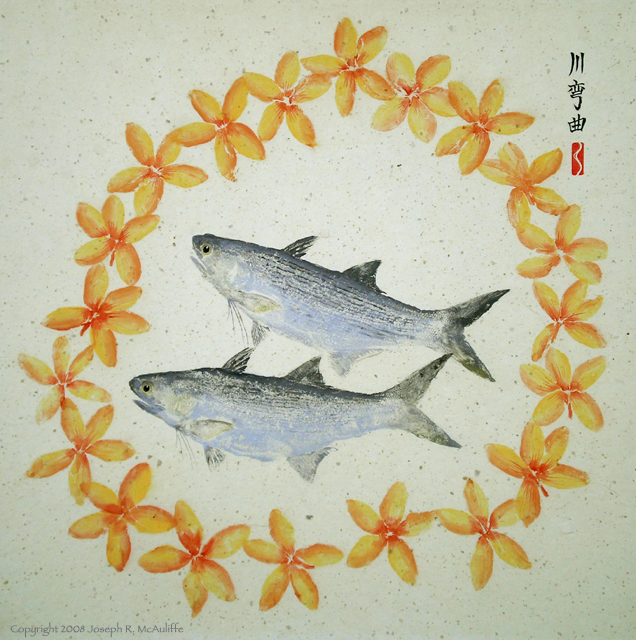
A lei of sweet-smelling frangipani surrounds a pair of Hawaiian moi. This is one of the most culturally important fishes in Hawaii. In ancient times, only male ali’i (royalty) were allowed to eat this delicious fish. A commoner caught tasting the regal treat was executed. The native Hawaiians long ago raised moi for their rulers in pens that extended from shore near the mouths of rivers. The pens were built of rock walls and closed off with gates made of lashed sticks. The ancient cultivation of moi probably represents the oldest fish farming in what is now the United States. With the end of the Hawaiian monarchy in the 1890s, cultivation of this fish declined and knowledge of the ancient ways nearly disappeared altogether. In addition, fishing pressure in shallow coastal waters greatly reduced wild populations of this native fish. Experiments on propagating moi in Hawaii began in the 1990s and now this fish is raised commercially in giant, anchored enclosures in deep water offshore. Moi are now commonly sold in the fresh fish markets and restaurants of Honolulu. Now anyone may eat a meal of delicious white, flaky moi (although it may cost a king’s ransom!).
Another common name of this fish is Pacific threadfin, a member of the threadfin family (Polynemidae). This family contains over 30 different species that are found in tropical and subtropical waters. The name threadfin refers to the long, filamentous, independent fin rays near the leading edges of the pectoral fins. These structures probably are organs that help the fish sense their prey – crabs, shrimps, tiny fish, and other small animals found on the bottom.
As Pacific threadfin grow in size, they change sex. They become sexually mature males at a rather small size, 12-15 cm. With further growth, they begin to change sex, first passing through a hermaphroditic stage and then becoming females when they reach a size of 18-24 cm. Although many kinds of fish change sex as they grow, these changes usually involve a change from smaller, younger females to older, larger males (for example, in the wrasses and parrotfishes; see Gallery 1). Sex change in the threadfins is the opposite.
Recipe - Moi Fit for a King (from Jonathan, born and raised in Hilo, Hawaii):
- Purchase the freshest, iced fish that have not been previously frozen.
- Clean fish (remove scales, head, viscera, and fins, leaving the tail on).
- Prepare garnish: Finely chop a small amount of fresh ginger, a moderate amount of fresh garlic, and several fresh, whole green onions, including the green tops.
- Put kettle of water on to boil.
- Using a very sharp knife, score flesh on each side of fish with vertical cuts to the backbone, about 1/2 inches apart; place whole prepared fish in a ceramic or pyrex glass bowl with a close-fitting lid. A plate can serve as a convenient lid for a round bowl.
- Pour boiling water over top of fish and cover bowl with lid; allow to stand about 5 minutes.
- Carefully turn fish over with two forks or other suitable implements; once again pour boiling water over fish and cover for about 5 minutes.
- Carefully remove whole fish from bowl and place on serving tray, place chopped ginger, garlic, and onions on top.
- Heat a small amount (~2 tablespoons) of peanut oil to smoking hot, carefully pour sizzling oil on top of fish covered with ginger-garlic-onion garnish. The moi is ready to serve to your royal guest!
Size: 25 X 24 inches (2007)
Return to Gallery 7.